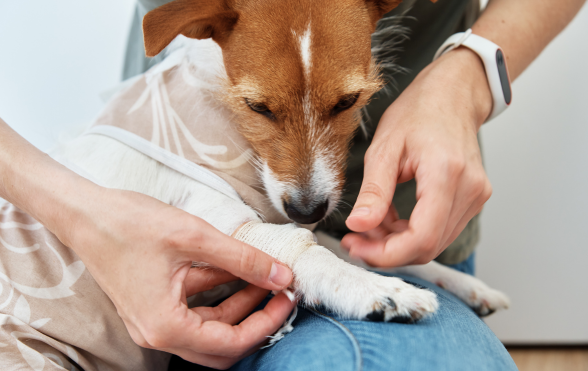As a pet business owner, you understand the responsibility that comes with caring for someone’s beloved pet. While you strive to provide the safest environment possible, accidents can happen. Whether it’s a minor scrape or a more serious injury, knowing how to respond calmly and professionally is key to prioritising the pet’s welfare, maintaining client trust, and protecting your business.
Here’s a guide to help you prepare for and handle pet injuries with confidence.
Be prepared and plan ahead
The best way to handle pet injuries is by having a plan in place before anything happens. Preparation not only protects the pets in your care but also gives you and your clients peace of mind.
Here’s how to get ready:
- Obtain owner consent: Always have written consent from pet owners to seek emergency veterinary care if needed.
- Collect medical information: Make sure you have details about the pet’s health, including medical history, regular vet contact, medications, and known conditions.
- Establish communication protocols: Know how and when to contact pet owners, especially if they’re unreachable during an emergency.
- Create a back-up plan: If you’re the sole carer, have a plan in place for other pets in your care if you need to handle an emergency.
What to do if a pet gets injured
Accidents can happen during a walk, at home, or in your workplace. When a pet gets injured, acting quickly and calmly is essential.
Steps to take:
- Ensure safety: Move the pet to a safe area, away from hazards like traffic, sharp objects, or other animals.
- Use restraints if needed: Depending on the situation, a lead, harness, or muzzle may help prevent further injury or aggressive behavior from a pet in pain.
- Assess the injury: Stay calm and evaluate the severity of the injury. Determine if basic first aid will suffice or if immediate veterinary care is required.
- Contact the owner: Notify the pet owner as soon as possible. If they’re unreachable, follow any pre-agreed emergency protocols.
- Document the incident: Record key details like time, location, what happened, actions taken, and any communications with the owner. This ensures transparency and can help with insurance claims.
- Handle third-party involvement: If another animal or person is involved, collect their contact details and file a report with the relevant authorities if necessary. Always prioritise the pet’s wellbeing and remain professional.
Be familiar with pet first aid
Your first step in an emergency is to provide immediate care. It’s a legal requirement to have a pet first aid kit at your premises and advisable to carry a portable kit during walks or outings.
Basic first aid can include cleaning wounds, applying bandages, or stabilising the pet until they can be seen by a vet. Familiarise yourself with pet first aid techniques or think about taking a certified pet first aid course to boost your confidence.
Follow up with pet owners
After the incident, it’s vital to maintain open communication with the pet owner. Keep them updated on their pet’s recovery, share relevant vet feedback, and explain the actions you took during the incident.
This follow-up shows your commitment to professionalism, builds trust, and reassures your clients that their pets are in good hands.
Protect your business with insurance
No matter how careful you are, accidents can happen. That’s why having comprehensive insurance for your pet business is crucial.
The right insurance can:
- Cover unexpected veterinary fees
- Protect you against liability claims
- Provide peace of mind for both you and your clients
Getting a quote is quick and easy. Get a pet business quote online, or call our friendly team on 0345 982 5499.


13 thoughts on “Handling pet injuries in your care: A guide for pet business owners”
Comments are closed.